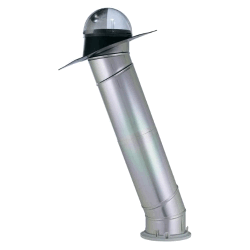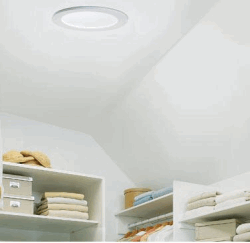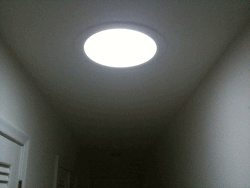Solar Tube Skylights: Remote Daylighting Made Easy
Solar tube skylights can provide daylight to areas of your home where a traditional skylight is not easily installed.
Solar tube skylights can bright daylight to almost any area of your home. When we think of skylights, we tend to think of glass windows in ceilings, or perhaps short, domed skylights with the sky immediately overhead. In all of these cases, skylights function similarly to windows. However, solar tubes are quite different. They allow us to provide natural light for rooms remotely. The natural source of light can be far removed from the place in your home where you want your sunlight to appear.
This makes solar tubes skylights fantastic for spreading natural light around your home. In theory, it would usually be possible to bring natural light to every room. In practice, solar tubes are easily installed in any room that lacks a room above it. In this article, I will discuss solar tube skylights, how they work, and how to make the best use of them in your home.
How Solar Tube Skylights Work

This solar tube skylight, available from Amazon, provides an example of how they are constructed.
Abandon everything you thought you knew about skylights; solar tube skylights are completely different from anything you might be used to. Solar tube skylights have three different functions: first, they collect light; next, they transfer that light; finally, they emit the light.
Light Collection: Solar tubes will collect sunlight from outside your home, usually from on top of your roof, where the light is unobstructed during the day (be careful about this; if a tree goes above your house, it could really affect the amount of light emitted). It is collected using a dome-shaped top called a “copula” that collects light from all directions, and then emits it in a single direction using reflectors. These copulae function similarly to reflector light bulbs, taking light from multiple directions and then sending them in a single direction.
Light Transference: Solar tubes will then transfer this light to the other end where it is to be emitted. For the most part, the interior of these tubes is simply a highly reflective surface that keeps the light bouncing toward the other end. Light can even be transferred around corners with only a little bit of light loss, though only straight solar tubes are usually available for home use.
Light Emission: Finally, the solar tube emits the light from the other end through what is called a “diffuser”. This functions similarly to diffusers on recessed light fixtures: the light has its beams broken up and sent in various directions. In fact, it solar tubes and recessed lighting cans with diffusers look quite similar in their shape, though the solar light will have a different color and quality from recessed lighting.
Costs

Solar tubes look a lot like recessed lighting cans, but the light is brighter and more diffuse.
Solar tube skylights are actually surprisingly inexpensive. As long as the room into which you wish to install the skylight does not have any other rooms above it, you can generally expect to spend anywhere from $250 to $1000 for the solar tube itself and another $150 or so for installation. On average, then, you can expect to spend around $700 for each tube.
The variation in costs is the result of difference in the quality of the lighting system. Small solar tubes, though, do not generally have wide variations in the quality of the light produced. Remember, solar tubes don’t actually generate light; they just transmit it. Higher-end systems will do a better job of collecting light and reflecting that light, so they will be somewhat brighter. However, at the end of the day, there will not be a great deal of difference in quality between the highest-end systems and any reasonably functional inexpensive system. Just make sure that your copula or diffuser is UV-protecting, so you don’t damage your furnishings.
Using Solar Tube Skylights
To avoid “cave” effects: If you’ve decided to use some solar tubes, where is the best place for them? Perhaps the most important place to put them is to place them so as to avoid what I’ve elsewhere called the “cave” effect. When a room with a window is deeper than it is tall, the non-windowed end tends to look far too dark. In these rooms, solar tubes will brighten the dark side of the room right up, removing the cave effect.
To offset large windows: Another place that solar tube skylights look especially good is in any room that has large windows. Large windows are beautiful, but they can have the effect of having the room looked imbalanced, with the windowed-side of the room simply overwhelming the other side in terms of interest. By placing solar tubes in rooms with large windows, the entire room gets brightened up, allowing it to hold interest from the otherwise-too-exciting open windows.
For offices: Offices require strong light that does not create harsh shadows. This allows us to work without constantly having too squint at what is written in the shadow of our pens. In addition, if you do any design or artistic work, having white light is very important. Light from solar tubes fulfills all of the requirements of office lighting. It is very bright, diffuse and white colored. As a result, solar tubes are great in offices and especially design studios.

Solar tubes can reach windowless hallways, providing otherwise impossible sunlight. Photograph courtesy of Styro.
For kitchens: Like offices, kitchens require good lighting for food preparation and cleaning. In addition, the appropriate color of lighting is very important for kitchen lighting, to ensure that food is properly cooked before serving. Solar tube skylights provide strong lighting that is whiter than many artificial sources of light. As a result, having a solar tube or two in a food preparation area can make the area an easier (and more pleasant) place to prepare food.
Putting It All Together
Solar tubes allow you to easily and reasonably inexpensively introduce natural light to otherwise inaccessible places in your home:
- They work by collecting light and transferring it through a tube to their destinations.
- Rooms do not need to be immediately adjacent to the room for solar tubes to work.
- They cost on average $700 each, though there is not a large difference in quality between high-end and mid-range systems.
- They can be used to avoid “cave” effects, balance out large windows and provide quality task lighting.
Solar tube skylights are an important resource for those looking to improve the amount of natural lighting in their homes.
Back from Solar Tube Skylights to Natural Lighting Principles